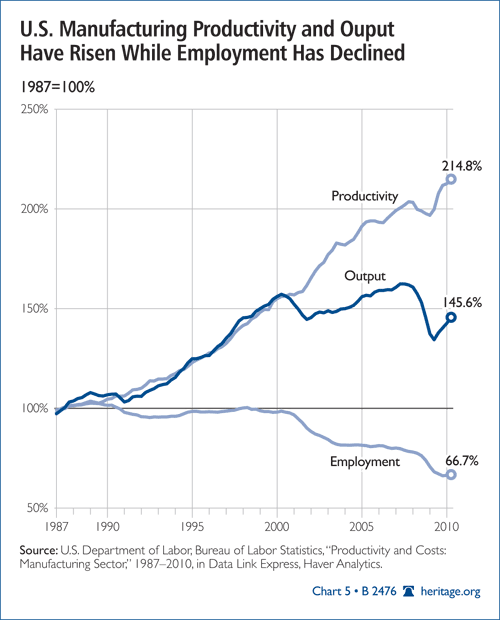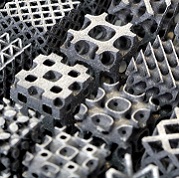|
ElCondemn posted:Does this mean that because production has flatlined we're losing growth in these industries to globalization or something? I don't understand why that number is unmoving, demand is increasing for these good so it should all be rising as our population grows, no? I'd read it as we're installing new robots but we're not building new factories or even new lines in the existing factory.
|
|
|
|

|
| # ? May 8, 2024 22:58 |
|
I'm guessing the end game is all work is done by robots, and the robots are "nationalized" so they are owned by everyone instead of a few ultra wealthy capitalists.
|
|
|
|
Increase in total number of robots has not been accompanied by increased domestic production of manufacturing equipment. No statement is made about any sector besides manufacturing of more manufacturing equipment. Possible explanations: 1) People are buying foreign-made manufacturing equipment. Total robots is a count in use, the data is presumably from the US annual survey of manufacturers 2) People are adding robots to existing equipment (+robot count) but are retrofiting the equipment instead of replacing it (steady equipment cost) 3) Low dollar value manufacturing equipment is being automated (automating a $100M industrial press and a $30K sewing machine are both +1 robots but very different dollar amounts of new equipment sales) Total US manufacturing production is still going up, this is just one of the sectors that isn't. 
|
|
|
|
Drive.ai announced a self-driving shuttle service in Frisco, TX: https://medium.com/@andrewng/self-driving-cars-are-here-aea1752b1ad0 This little bit is an interesting idea: quote:While a human driver would make eye contact with a pedestrian to let them know it is safe to cross, a driverless car cannot communicate the same way. Thus, a self-driving car must have other ways to communicate with people around it. Drive.ai is using exterior panels to do this. Waymo's car got into a significant accident, and by "got into a significant accident" I mean another car jumped the median and hit it: https://www.youtube.com/watch?v=KhcyTOaHdv4
|
|
|
qkkl posted:I'm guessing the end game is all work is done by robots, and the robots are "nationalized" so they are owned by everyone instead of a few ultra wealthy capitalists. Sounds like COMMUNISM to me. No seriously, this is what communism is, and things are likely to end up there, whether via peaceful, gradual progress towards it or via violent revolution once we (globally) reach the "few ultra-wealthy capitalists" stage. Something I don't think I've seen in this thread is stuff about automated building. Some cool stuff going on: https://www.youtube.com/watch?v=2-VR4IcDhX0 There are some things you can't fully automate easily (tiling a bathroom for example) but I think what you'll end up with is similar to this bricklaying robot - it does most of the work but it has to be finished off/tidied up by hand. This is still good because it increases overall productivity, keeps at least some humans in jobs and takes out the back-breaking donkey work for people.
|
|
|
|
|
Foxfire_ posted:Increase in total number of robots has not been accompanied by increased domestic production of manufacturing equipment. No statement is made about any sector besides manufacturing of more manufacturing equipment. Actually, in recent years there's been quite a bit of emphasis on robots intended for #3 - low-cost light-duty robots which can be quickly set up by people with no extensive experience in robot programming. https://www.universal-robots.com/ https://www.rethinkrobotics.com/ Cicero posted:Waymo's car got into a significant accident, and by "got into a significant accident" I mean another car jumped the median and hit it: https://www.youtube.com/watch?v=KhcyTOaHdv4 One of the articles I saw claimed that the Waymo van was in manual mode at the time. I've heard nothing to indicate whether they (or anyone else) has made any progress in allowing a car to actively dodge in such a situation (which most humans probably couldn't do reliably).
|
|
|
|
Cockmaster posted:One of the articles I saw claimed that the Waymo van was in manual mode at the time. I've heard nothing to indicate whether they (or anyone else) has made any progress in allowing a car to actively dodge in such a situation (which most humans probably couldn't do reliably). edit: I'm kind of confused as to why the video quality is so lovely in the video Waymo posted though. Surely the actual cameras on the vehicle aren't that low-res. Cicero fucked around with this message at 13:57 on May 8, 2018 |
|
|
|
ElCondemn posted:Does this mean that because production has flatlined we're losing growth in these industries to globalization or something? I don't understand why that number is unmoving, demand is increasing for these good so it should all be rising as our population grows, no? Well, robots increase the amount of output that can be produced by a given number of people. So if the number of robots goes up and the amount of output doesn't go up, that means that the number of people has gone down. In other words, the robots are being used to eliminate jobs rather than to increase production, which flies in the face of basically the entire history of automation. An awful lot of people find this pretty alarming, since most rosy assessments of future automation's impact depend on the trends from previous automation waves always being true. If automation is going up lots and output is holding steady or only slightly increasing, then that means that either jobs are going down or the industry is wasting lots of money on useless automation that doesn't work and does nothing. And somehow I doubt it's the latter (except maybe in Tesla factories). You can quite clearly see the impact of the recessions in the chart, too. In both 2001 and 2008, manufacturing output drops drastically and never returns to its previous high, while the number of robot patents suddenly doubles or more. The number of robots isn't directly tracked in 2001, but you can see how it suddenly starts shooting up in 2009 after having been basically flat for the previous five years. The fact that the automation increases correspond to economic dips rather than technological advances or economic prosperity is just another piece of evidence to suggest that these robots are primarily being used for job elimination rather than as investments in future growth. As for demand, is it increasing? Because output largely isn't. Even in manufacturing output as a whole, we're only a little over what we were in 2005, which isn't that far above where we were in 1998. There's been plenty of year-over-year growth, but pretty much all of it has been in recovery, since the last couple of recessions have taken much bigger bites out of manufacturing output than previous recessions had.  This chart is a pretty good example. Note how everything follows a straightforward trend until 2000: productivity and output rise steadily in tandem while employment holds steady. Then the recession hits, and suddenly output slows to a near-stop while employment starts dropping - but productivity continues to grow at almost the same pace. Then everything continues on those new trends until 2008, when the same thing happens again. Cockmaster posted:One of the articles I saw claimed that the Waymo van was in manual mode at the time. I've heard nothing to indicate whether they (or anyone else) has made any progress in allowing a car to actively dodge in such a situation (which most humans probably couldn't do reliably). Well, automated cars are almost always in manual mode at the time of a collision, because they've got someone at the wheel whose entire job is to take over manual control if they think an collision is about to happen. So "it was in manual mode at the time" isn't actually all that meaningful.
|
|
|
|
Main Paineframe posted:Well, automated cars are almost always in manual mode at the time of a collision, because they've got someone at the wheel whose entire job is to take over manual control if they think an collision is about to happen. So "it was in manual mode at the time" isn't actually all that meaningful.
|
|
|
|
Is there a version of this not from heritage?
|
|
|
|
BrandorKP posted:Is there a version of this not from heritage? https://www.heritage.org/jobs-and-labor/report/technology-explains-drop-manufacturing-jobs edit: link wasn't working pangstrom fucked around with this message at 17:34 on May 8, 2018 |
|
|
|
Oh yeah I think it's a decent enough chart. That's just going to make a bunch of people ignore it.
|
|
|
|
Google just showed off the assistant automatically calling real humans to book appointments/reservations for a haircut place and a restaurant and it was impressive as hell assuming it's reliable at all (which I have serious doubts on...there's just so many ways things can go wrong).
|
|
|
|
Cicero posted:Well yeah, it depends on whether it means "the safety driver took control at the last second once it was apparent something bad was happening" or "the safety driver had already switched over to manual control for reasons other than the impending crash". I think people are assuming "the car was in manual mode" means the latter, but I could see it being the former too. It's the former, but the reason they say it the way they do is because they want people to think it's the latter
|
|
|
|
WhatEvil posted:Something I don't think I've seen in this thread is stuff about automated building. Some cool stuff going on: But if you really want to put up a wall quickly at scale, you can pour concrete or even use metal-frame construction of prefab parts and panels. The automated bricklayer robot is more about fulfilling gimmicky aesthetic choices - indeed look at how its demonstration there is cosmetic brick for a building that doesn't need brick to stay up. The building customer interesting in eliminating as much cost as possible is simply going to use far simpler methods like paint or stucco. No job for the bricklayer at all, but of course there's been a lot less jobs for them for many years.
|
|
|
|
ElCondemn posted:Does this mean that because production has flatlined we're losing growth in these industries to globalization or something? I don't understand why that number is unmoving, demand is increasing for these good so it should all be rising as our population grows, no? I think it is a combination of things. For example, labor cost and energy cost. Labor cost still varies greatly throughout the world. However, in terms of energy... I would not say this is necessarily the case. It is getting to the point where energy costs for a regions, not seperated by oceans are turning into... constants. From the perspective of a person who is after a local market, robots make sense. You have to pay the energy cost anyway, why not pay a little bit more, for the robots and run 24-7? But from an employment perspective, I would say we have too many people as-is right now to ensure everyone gets the job and opportunities they deserve. Life is poo poo. Senor P. fucked around with this message at 04:07 on May 9, 2018 |
|
|
|
Cicero posted:Google just showed off the assistant automatically calling real humans to book appointments/reservations for a haircut place and a restaurant and it was impressive as hell assuming it's reliable at all (which I have serious doubts on...there's just so many ways things can go wrong). https://www.youtube.com/watch?v=lXUQ-DdSDoE It's impressive but creepy too. Especially since they add little fake uhhmms that mimic human speech. If I was the human on the other end of the call I'd prefer knowing I'm talking with a computer. Communicating successfully should be the goal, not duping other participants.
|
|
|
Doctor Malaver posted:It's impressive but creepy too. Especially since they add little fake uhhmms that mimic human speech. If I was the human on the other end of the call I'd prefer knowing I'm talking with a computer. Communicating successfully should be the goal, not duping other participants. But if you were the receptionist for a dentist and you figured out that it was a robot that was talking to you, wouldn't you assume it was some sort of scam and hang up? I think I would, and so would a percentage of other people.
|
|
|
|
|
Doctor Malaver posted:https://www.youtube.com/watch?v=lXUQ-DdSDoE quote:The system also sounds more natural thanks to the incorporation of speech disfluencies (e.g. “hmm”s and “uh”s). These are added when combining widely differing sound units in the concatenative TTS or adding synthetic waits, which allows the system to signal in a natural way that it is still processing. (This is what people often do when they are gathering their thoughts.) In user studies, we found that conversations using these disfluencies sound more familiar and natural.
|
|
|
|
fishmech posted:But if you really want to put up a wall quickly at scale, you can pour concrete or even use metal-frame construction of prefab parts and panels. The automated bricklayer robot is more about fulfilling gimmicky aesthetic choices - indeed look at how its demonstration there is cosmetic brick for a building that doesn't need brick to stay up. The building customer interesting in eliminating as much cost as possible is simply going to use far simpler methods like paint or stucco. No job for the bricklayer at all, but of course there's been a lot less jobs for them for many years. The number of buildings using brick as a structural element in 2018 is tiny. It’s all cosmetic. The bricklayers it replaces are “only” doing cosmetic work. very few people are making brick buildings anymore.
|
|
|
Owlofcreamcheese posted:The number of buildings using brick as a structural element in 2018 is tiny. It’s all cosmetic. The bricklayers it replaces are “only” doing cosmetic work. very few people are making brick buildings anymore. There's no reason to think that the robot shown couldn't also be adapted to also make structural, double-skin brick walls. Regardless of whether they're structural or cosmetic, brick walls are still getting built and robots are able to do it.
|
|
|
|
|
WhatEvil posted:There's no reason to think that the robot shown couldn't also be adapted to also make structural, double-skin brick walls. Sure, of course, but even if for some reason it couldn't the vast majority of brick work is this way, not fully structural. Even things called "solid brick construction" are mostly concrete on the inside not two layers of actual red brick like an 1800s town house or something.
|
|
|
|
I feel like construction chat is a pretty good example the sort of blind spot people have about automation and labor-saving technologies. Sure, they still require human workers - but a lot fewer than they did a century ago. Heavy machinery and power tools have drastically reduced the amount of man-hours needed to accomplish various construction tasks, replacing much of the manual labor and simple drudgery with more skillful and knowledge-based work (though I know a lot of people don't really think of construction that way). There's still plenty of manual labor, of course, but it's much reduced compared to the days when bricks had to be made on-site in a mobile mini-kiln rather than trucked in from a brick factory. A team of ditch-diggers can easily be replaced by one guy with a powered backhoe, which wasn't invented until after WWII. I think bricklaying is going to survive the current wave of automation, which tends to rely on a carefully controlled environment and doesn't quite have the versatility the task requires. But that doesn't mean that construction is automation-proof: it just means that every construction task that meets the standards of today's automation technology had already been automated away by previous waves of automation technology. Most of that happened more than two decades ago, so our generation tends to treat it as the way things always were and regard construction as not yet impacted by automation. However, I think that's a mistake on our part. When talking about automation, it's important to remember that every single construction job that exists today was one that either survived the previous automation of construction work or was created by it.
|
|
|
|
Main Paineframe posted:Most of that happened more than two decades ago, so our generation tends to treat it as the way things always were and regard construction as not yet impacted by automation. However, I think that's a mistake on our part. When talking about automation, it's important to remember that every single construction job that exists today was one that either survived the previous automation of construction work or was created by it. the problem with this though is people misconstruting where automation enters the construction process like, robots that duplicate the work of craftsmen are complicated and high tech and flashy. meanwhile, construction has been heavily automated for decades already, see manufactured housing, because it makes way more sense to use robots to stamp out prefab parts in a central location assembled on site then to use robots to assemble traditional materials on site:   same thing with automation in fast food. the burger flipping robot is a dumber idea than the robot cranking out tens of thousands of frozen meat patties
|
|
|
|
The big efficiency gains were definitely in tools but also prefabrication. Many new homes and buildings just get large parts of the building shipped to the construction site and craned into place.
|
|
|
|
ElCondemn posted:The big efficiency gains were definitely in tools but also prefabrication. Many new homes and buildings just get large parts of the building shipped to the construction site and craned into place. Definitely this. Most of the automation in construction wont actually be at the jobsite for the average driver-by to see. It’s all at prefabrication factories. Just in my fire protection industry, a steel sprinkler system with miles of pipe for a warehouse used to take months of cutting and threading pipe to install. Now we can put up 100k sqft of protection piping in like 5 days with two guys since all the pipe is cut and welded by robots to exact spec(relatively speaking) and just dropped off to be put together like legos.
|
|
|
|
WhatEvil posted:There's no reason to think that the robot shown couldn't also be adapted to also make structural, double-skin brick walls. Or integrated into a concrete 3D printer: https://www.youtube.com/watch?v=8z-iebHRxJk
|
|
|
|
SpaceCadetBob posted:Most of the automation in construction wont actually be at the jobsite for the average driver-by to see.
|
|
|
|
Cockmaster posted:Or integrated into a concrete 3D printer: Ehh, this is a kinda cool tech demo, but it really misses a lot of the point when it comes to the complexities of affordable living, land use, and density. High density living is honestly the future, but the construction process for said housing is also a hell of a lot more complicated than pouring a concrete 800 sqft mold. On the brick layer robot. A recent medical building job of ours got a whole brick facade and I’m pretty sure by the end the brick layers would have been happy to have that robot help. poo poo sucked.
|
|
|
|
Re: Construction, there's also stuff like this: https://www.youtube.com/watch?v=vYCDDVARZJU Robots are definitely coming for site construction stuff... but yes the point that pre-fabricated stuff will become more common is correct too. I actually live like a mile from this development:  This is Oxley Woods in the UK, where 145 houses were all manufactured offsite in one week and then took ~2 weeks on site to fully finish, and this happened way back in 2005. There have been some problems since with buildings leaking etc. so there are some improvements to be made, but the principle is sound.
|
|
|
|
|
WhatEvil posted:Robots are definitely coming for site construction stuff... but yes the point that pre-fabricated stuff will become more common is correct too. I actually live like a mile from this development: will become more common? basically every tall concrete building has prefab bones. it's been done that way for decades WhatEvil posted:so there are some improvements to be made, but the principle is sound. decades old again https://en.wikipedia.org/wiki/Lustron_house hell, https://en.wikipedia.org/wiki/Kit_house
|
|
|
|
there's a buster keaton silent comedy film from 1920 about him trying and failing to put together a prefab home. 100 years ago https://www.youtube.com/watch?v=sFLHbpBPahE
|
|
|
|
That you could buy from the Sears catalog https://www.popularmechanics.com/home/how-to-plans/a20859/sears-sold-70000-homes-from-their-catalog-are-you-living-in-one/ http://www.searsarchives.com/homes/1908-1914.htm
|
|
|
|
https://www.youtube.com/watch?v=Ve9kWX_KXus I absolutely hate that this thing walks down stairs "backwards" and I wonder how much of eventual robot design will end up having to work around a bunch of arbitrary rules of stuff that humans find unsettling vs peak efficiency. Like maybe I and everyone would just get used to it after seeing it a few times, but I can imagine a ton of pressure to make it walk down stairs "correctly" instead of "weird" because it really is grating to watch because it's not doing it right, despite it clearly having none of the actual issues that exist to make walking down stairs backwards wrong.
|
|
|
|
Owlofcreamcheese posted:https://www.youtube.com/watch?v=Ve9kWX_KXus The fact that they’ve continued work on this robot design for as long as they have is weird. Everyone that sees that thing is unsettled. The way it sounds and moves is just disturbing to people, how do the creators not see this?
|
|
|
|
ElCondemn posted:The fact that they’ve continued work on this robot design for as long as they have is weird. Everyone that sees that thing is unsettled. The way it sounds and moves is just disturbing to people, how do the creators not see this? The mechanical hound slept but did not sleep, lived but did not live in its gently humming, gently vibrating, softly illuminated kennel back in a dark corner of the firehouse.
|
|
|
|
ElCondemn posted:The fact that they’ve continued work on this robot design for as long as they have is weird. Everyone that sees that thing is unsettled. The way it sounds and moves is just disturbing to people, how do the creators not see this? The sound just has to be inherent to the muscle technology they use. I think they did make some attempt to tone it down a little, the first ones all had a weird look of having too human legs, where it was four legged but looked like a weird squatting set of people facing each other instead of animal legs. Now they look like they are animal legs that look like they are attached way too diagonal so they look like insect legs. Which is still like 1000 times worse than if they looked like quadruped legs are "supposed" to look, but is at least way better than looking like it had biped legs but too many of them. edit: also i wonder if they intentionally make them a little awful looking because they are always so loving mean to them and it's already hard to watch and I bet it would be unbearable for the public if they were given more relatable faces and bodies and stuff. like he is yanking on that tail and the robot HATES it, and I know it's not a real animal but it already makes me angry to watch this guy gently caress with this dog monster, just because of evolved pathways to recognize struggle or pain in helpless animals, I feel like there would be a congressional investigation into robot cruelty if they posted videos like this but styled the dog as some more relatable realistic form: https://www.youtube.com/watch?v=aFuA50H9uek Owlofcreamcheese fucked around with this message at 04:37 on May 12, 2018 |
|
|
|
Owlofcreamcheese posted:https://www.youtube.com/watch?v=Ve9kWX_KXus Owlofcreamcheese posted:edit: also i wonder if they intentionally make them a little awful looking because they are always so loving mean to them and it's already hard to watch and I bet it would be unbearable for the public if they were given more relatable faces and bodies and stuff. like he is yanking on that tail and the robot HATES it, and I know it's not a real animal but it already makes me angry to watch this guy gently caress with this dog monster, just because of evolved pathways to recognize struggle or pain in helpless animals, I feel like there would be a congressional investigation into robot cruelty if they posted videos like this but styled the dog as some more relatable realistic form: 1)  2) it's a good reminder that "is thing good or bad" is not properly answered by "does thing look like other thing"
|
|
|
|
ElCondemn posted:The fact that they’ve continued work on this robot design for as long as they have is weird. Everyone that sees that thing is unsettled. The way it sounds and moves is just disturbing to people, how do the creators not see this?
|
|
|
|

|
| # ? May 8, 2024 22:58 |
|
suck my woke dick posted:it's a good reminder that "is thing good or bad" is not properly answered by "does thing look like other thing" Maybe the robot would tell you that, but humans don't work that way. Obviously it's a literal mindless automaton that can not feel pain or frustration, so you don't have to design it to not react as if it's suffering for it's benefit, but you still have to think about that stuff for the viewer. Humans have deep cultural and even biological reactions to things that appear alive and you need to account for that in design.
|
|
|


























 I CANNOT EJACULATE WITHOUT SEEING NATIVE AMERICANS BRUTALISED!
I CANNOT EJACULATE WITHOUT SEEING NATIVE AMERICANS BRUTALISED!